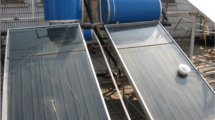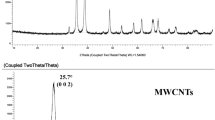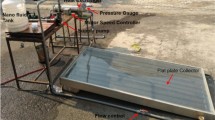Abstract
The impact of population explosion and continuous upsurge on energy demand has resulted in the intimidating depletion of fossil fuel resources, increased environmental pollution, and elevated production and consumption cost. Hence, in the past two decades the demand for renewable energy has escalated. The solar energy is the most trending topic when talking about renewable energy sources, because of its ease of availability, reduced dependence on foreign fuels and negligible maintenance. This can be directly harnessed unlike other renewable energy sources. A solar flat plate collector converts the radiant solar energy from the sun into thermal energy; usually, copper or aluminium is used as heat absorbing material. However, to further enhance the performance and thermophysical properties of the heat exchanger liquids of flat plate solar collectors like radiative heat transfer and thermal conductivity, the nanofluids are used. The use of nanofluids as an innovative type of working fluids is reasonably a new development in solar flat plate collectors. They are prepared by mixing low concentration of solid particles, sized 1–100 nm with the base fluid. The objectives of this review paper is to recapitulate the investigations carried in the field of solar flat plate collectors using a range of nanofluids, the performance analysis of various flat plate collectors using numerous nanofluids and the challenges faced in developing an efficient thermal collector using nanofluids. Furthermore, the article discusses the opportunities for future research.










































Similar content being viewed by others
Abbreviations
- A c :
-
Collector area (m2)
- ASHRAE:
-
American Society of Heating, Refrigerating, and Air-Conditioning Engineers
- C p :
-
Specific heat of fluid (J kg−1 K−1)
- CNT:
-
Carbon nanotube
- CTAB:
-
Cetyl trimethylammonium bromide
- d :
-
Diameter of tube (m)
- DASC:
-
Direct absorption solar collector
- EG:
-
Ethylene glycol
- \({\dot{\text{E}}\text{x}}\) :
-
Exergy rate (J kg−1 s−1)
- FPSC:
-
Flat plate solar collector
- F R :
-
Heat removal factor
- GNP:
-
Graphene nanoplatelet
- G S :
-
Absorbed solar energy per m2
- G T :
-
Incident solar radiation (W m−2)
- k :
-
Thermal conductivity (W m−1 K−1)
- L :
-
Length of tube (m)
- \(\dot{m}\) :
-
Mass flow rate (kg s−1)
- MWCNT:
-
Multiwalled carbon nanotubes
- PEG 400:
-
Polyethylene glycol 400
- PVD:
-
Physical vapor deposition
- Q u :
-
Useful energy gain
- SDBS:
-
Sodium dodecyl benzene sulfonate
- SDS:
-
Sodium dodecyl sulfate
- \(\dot{S}_{\text{gen}}\) :
-
Entropy generation rate (J kg−1 K−1 s−1)
- SWCNT:
-
Single-walled carbon nanotube
- T a :
-
Ambient temperature (K)
- T i :
-
Inlet fluid temperature (K)
- T o :
-
Outlet fluid temperature (K)
- T s :
-
Light source temperature (K)
- U L :
-
Overall heat loss
- V :
-
Velocity of fluid flowing (L min−1)
- \(\alpha\) :
-
Absorptance of absorber plate
- \(\rho\) :
-
Density of fluid
- \(\tau\) :
-
Transmittance of glass cover
- \(\eta_{\text{c}}\) :
-
Collector efficiency
- µ :
-
Dynamic viscosity (Pa-s)
- bf:
-
Base fluid
- nf:
-
Nanofluid
- np:
-
Nanoparticles
References
Kalogirou SA. Solar energy engineering: processes and systems. Cambridge: Academic Press; 2013.
Ohler A, Fetters I. The causal relationship between renewable electricity generation and GDP growth: a study of energy sources. Energy Econ. 2014;43:125–39.
Alper A, Oguz O. The role of renewable energy consumption in economic growth: evidence from asymmetric causality. Renew Sustain Energy Rev. 2016;60:953–9.
Tugcu CT, Ozturk I, Aslan A. Renewable and non-renewable energy consumption and economic growth relationship revisited: evidence from G7 countries. Energy Econ. 2012;34(6):1942–50.
Foster R, Ghassemi M, Cota A. Solar energy: renewable energy and the environment. Boca Raton: CRC Press; 2009.
Coskun C, Oktay Z, Dincer I. Thermodynamic analyses and case studies of geothermal based multi-generation systems. J Clean Prod. 2012;32:71–80.
AlZaharani AA, Dincer I, Naterer G. Performance evaluation of a geothermal based integrated system for power, hydrogen and heat generation. Int J Hydrog Energy. 2013;38(34):14505–11.
Jiaqiang E, et al. Effects of fatty acid methyl esters proportion on combustion and emission characteristics of a biodiesel fueled diesel engine. Energy Convers Manag. 2016;117:410–9.
Soudagar MEM, et al. The effect of nano-additives in diesel–biodiesel fuel blends: a comprehensive review on stability, engine performance and emission characteristics. Energy Convers Manag. 2018;178:146–77.
Zanuttigh B, Angelelli E, Kofoed JP. Effects of mooring systems on the performance of a wave activated body energy converter. Renew Energy. 2013;57:422–31.
Verma V, Kundan L. Thermal performance evaluation of a direct absorption flat plate solar collector (DASC) using Al2O3–H2O based nanofluids. ISOR J Mech Civil Eng. 2013;6:2320–3344.
Taylor RA, et al. Nanofluid optical property characterization: towards efficient direct absorption solar collectors. Nanoscale Res Lett. 2011;6(1):225.
Duffie JA, Beckman WA. Solar engineering of thermal processes. New York: Wiley; 2013.
Bogaerts WF, Lampert CM. Materials for photothermal solar energy conversion. J Mater Sci. 1983;18(10):2847–75.
Hottel H, Woertz B. Performance of flat-plate solar-heat collectors. Trans Am Soc Mech Eng (United States). 1942;64:91.
Mahian O, et al. A review of the applications of nanofluids in solar energy. Int J Heat Mass Transf. 2013;57(2):582–94.
Otanicar TP, et al. Nanofluid-based direct absorption solar collector. J Renew Sustain Energy. 2010;2(3):033102.
Khullar V, et al. Solar energy harvesting using nanofluids-based concentrating solar collector. J Nanotechnol Eng Med. 2012;3(3):031003.
Phelan P, et al. Trends and opportunities in direct–absorption solar thermal collectors. J Therm Sci Eng Appl. 2013;5(2):021003.
Sani E, et al. Carbon nanohorns-based nanofluids as direct sunlight absorbers. Opt Express. 2010;18(5):5179–87.
Minardi JE, Chuang HN. Performance of a “black” liquid flat-plate solar collector. Sol Energy. 1975;17(3):179–83.
Efficiency, G.G.E. 2013; Available from: http://www.green-group.rs/index.php?r=1780.
Daungthongsuk W, Wongwises S. A critical review of convective heat transfer of nanofluids. Renew Sustain Energy Rev. 2007;11(5):797–817.
Duangthongsuk W, Wongwises S. An experimental study on the heat transfer performance and pressure drop of TiO2–water nanofluids flowing under a turbulent flow regime. Int J Heat Mass Transf. 2010;53(1–3):334–44.
Gupta M, et al. A review on thermophysical properties of nanofluids and heat transfer applications. Renew Sustain Energy Rev. 2017;74:638–70.
Maiga SEB, et al. Heat transfer enhancement by using nanofluids in forced convection flows. Int J Heat Fluid Flow. 2005;26(4):530–46.
Ahuja AS. Augmentation of heat transport in laminar flow of polystyrene suspensions. II. Analysis of the data. J Appl Phys. 1975;46(8):3417–25.
Sohn CW, Chen M. Microconvective thermal conductivity in disperse two-phase mixtures as observed in a low velocity Couette flow experiment. J Heat Transf. 1981;103(1):47–51.
Choi SU, Eastman JA. Enhancing thermal conductivity of fluids with nanoparticles. Chicago: Argonne National Lab.; 1995.
Hwang Y, et al. Production and dispersion stability of nanoparticles in nanofluids. Powder Technol. 2008;186(2):145–53.
Yu W, Xie H. A review on nanofluids: preparation, stability mechanisms, and applications. J Nanomater. 2012;2012:1.
Sadri R, et al. A bio-based, facile approach for the preparation of covalently functionalized carbon nanotubes aqueous suspensions and their potential as heat transfer fluids. J Colloid Interface Sci. 2017;504:115–23.
Xiaowu W, Ben H. Exergy analysis of domestic-scale solar water heaters. Renew Sustain Energy Rev. 2005;9(6):638–45.
Ho C, Chen T. The recycle effect on the collector efficiency improvement of double-pass sheet-and-tube solar water heaters with external recycle. Renew Energy. 2006;31(7):953–70.
Ibrahim O, et al. Improved model for calculating instantaneous efficiency of flat-plate solar thermal collector. J Heat Transf. 2018;140(6):062801.
Mahian O, et al. Recent advances in modeling and simulation of nanofluid flows-part II: applications. Phys Rep. 2018;791:1–59.
Mahian O, et al. Recent advances in modeling and simulation of nanofluid flows-part I: fundamental and theory. Phys Rep. 2018;790:1–48.
Eastman JA, et al. Anomalously increased effective thermal conductivities of ethylene glycol-based nanofluids containing copper nanoparticles. Appl Phys Lett. 2001;78(6):718–20.
Rashidi S, et al. Applications of nanofluids in condensing and evaporating systems. J Therm Anal Calorim. 2018;131(3):2027–39.
Hong T-K, Yang H-S, Choi C. Study of the enhanced thermal conductivity of Fe nanofluids. J Appl Phys. 2005;97(6):064311.
Li Y, et al. A review on development of nanofluid preparation and characterization. Powder Technol. 2009;196(2):89–101.
Colangelo G, et al. A new solution for reduced sedimentation flat panel solar thermal collector using nanofluids. Appl Energy. 2013;111:80–93.
Pantzali M, Mouza A, Paras S. Investigating the efficacy of nanofluids as coolants in plate heat exchangers (PHE). Chem Eng Sci. 2009;64(14):3290–300.
Saidur R, Leong K, Mohammad H. A review on applications and challenges of nanofluids. Renew Sustain Energy Rev. 2011;15(3):1646–68.
Behi M, Mirmohammadi SA. Investigation on thermal conductivity, viscosity and stability of nanofluids. Stockholm: Royal Institute of Technology (KTH), School of Industrial Engineering and Management; 2012.
Hordy N, et al. High temperature and long-term stability of carbon nanotube nanofluids for direct absorption solar thermal collectors. Sol Energy. 2014;105:82–90.
Mahian O, et al. Heat transfer, pressure drop, and entropy generation in a solar collector using SiO2/water nanofluids: effects of nanoparticle size and pH. J Heat Transf. 2015;137(6):061011.
Sadri R, et al. Study of environmentally friendly and facile functionalization of graphene nanoplatelet and its application in convective heat transfer. Energy Convers Manag. 2017;150:26–36.
Li J, Li Z, Wang B. Experimental viscosity measurements for copper oxide nanoparticle suspensions. Tsinghua Sci Technol. 2002;7(2):198–201.
Hosseini M, et al. Numerical study of turbulent heat transfer of nanofluids containing eco-friendly treated carbon nanotubes through a concentric annular heat exchanger. Int J Heat Mass Transf. 2018;127:403–12.
Razi P, Akhavan-Behabadi M, Saeedinia M. Pressure drop and thermal characteristics of CuO-base oil nanofluid laminar flow in flattened tubes under constant heat flux. Int Commun Heat Mass Transf. 2011;38(7):964–71.
Duffie JA, Beckman W. Solar thermal engineering processes. New York: Wiley; 1980.
Standard AJASoH. Methods of testing to determine the thermal performance of solar collectors. 1977. p. 93–77.
Xuan Y, Roetzel W. Conceptions for heat transfer correlation of nanofluids. Int J Heat Mass Transf. 2000;43(19):3701–7.
Pak BC, Cho YI. Hydrodynamic and heat transfer study of dispersed fluids with submicron metallic oxide particles. Exp Heat Transf. 1998;11(2):151–70.
Zhang X, et al. Effective thermal conductivity and thermal diffusivity of nanofluids containing spherical and cylindrical nanoparticles. Exp Thermal Fluid Sci. 2007;31(6):593–9.
Nieto de Castro C, et al. Standard reference data for the thermal conductivity of liquids. J Phys Chem Ref Data. 1986;15(3):1073–86.
Corcione MJEC. Empirical correlating equations for predicting the effective thermal conductivity and dynamic viscosity of nanofluids. Energy Convers Manag. 2011;52(1):789–93.
Esfe MH, et al. Experimental determination of thermal conductivity and dynamic viscosity of Ag–MgO/water hybrid nanofluid. Int Commun Heat Mass Transf. 2015;66:189–95.
Javadi F, Saidur R, Kamalisarvestani M. Investigating performance improvement of solar collectors by using nanofluids. Renew Sustain Energy Rev. 2013;28:232–45.
Yousefi T, et al. An experimental investigation on the effect of MWCNT–H2O nanofluid on the efficiency of flat-plate solar collectors. Exp Thermal Fluid Sci. 2012;39:207–12.
Chaji H, et al. Experimental study on thermal efficiency of flat plate solar collector using TiO2/water nanofluid. Mod Appl Sci. 2013;7(10):60.
Sundar LS, Singh MK, Sousa AC. Enhanced heat transfer and friction factor of MWCNT–Fe3O4/water hybrid nanofluids. Int Commun Heat Mass Transf. 2014;52:73–83.
Said Z, et al. Performance enhancement of a flat plate solar collector using titanium dioxide nanofluid and polyethylene glycol dispersant. J Clean Prod. 2015;92:343–53.
Sharafeldin MA, Gróf G, Mahian O. Experimental study on the performance of a flat-plate collector using WO3/water nanofluids. Energy. 2017;141:2436–44.
Yousefi T, et al. An experimental investigation on the effect of Al2O3–H2O nanofluid on the efficiency of flat-plate solar collectors. Renew Energy. 2012;39(1):293–8.
Yousefi T, et al. An experimental investigation on the effect of pH variation of MWCNT–H2O nanofluid on the efficiency of a flat-plate solar collector. Sol Energy. 2012;86(2):771–9.
Zamzamian A, et al. An experimental study on the effect of Cu-synthesized/EG nanofluid on the efficiency of flat-plate solar collectors. Renew Energy. 2014;71:658–64.
Moghadam AJ, et al. Effects of CuO/water nanofluid on the efficiency of a flat-plate solar collector. Exp Therm Fluid Sci. 2014;58:9–14.
He Q, Zeng S, Wang S. Experimental investigation on the efficiency of flat-plate solar collectors with nanofluids. Appl Therm Eng. 2015;88:165–71.
Michael JJ, Iniyan S. Performance of copper oxide/water nanofluid in a flat plate solar water heater under natural and forced circulations. Energy Convers Manag. 2015;95:160–9.
Meibodi SS, et al. Experimental investigation on the thermal efficiency and performance characteristics of a flat plate solar collector using SiO2/EG–water nanofluids. Int Commun Heat Mass Transf. 2015;65:71–5.
Shojaeizadeh E, Veysi F, Kamandi A. Exergy efficiency investigation and optimization of an Al2O3–water nanofluid based flat-plate solar collector. Energy Build. 2015;101:12–23.
Vakili M, et al. Experimental investigation of graphene nanoplatelets nanofluid-based volumetric solar collector for domestic hot water systems. Sol Energy. 2016;131:119–30.
Ahmadi A, Ganji DD, Jafarkazemi F. Analysis of utilizing graphene nanoplatelets to enhance thermal performance of flat plate solar collectors. Energy Convers Manag. 2016;126:1–11.
Noghrehabadi A, Hajidavaloo E, Moravej M. Experimental investigation of efficiency of square flat-plate solar collector using SiO2/water nanofluid. Case Stud Therm Eng. 2016;8:378–86.
Verma SK, Tiwari AK, Chauhan DS. Performance augmentation in flat plate solar collector using MgO/water nanofluid. Energy Convers Manag. 2016;124:607–17.
Vincely DA, Natarajan E. Experimental investigation of the solar FPC performance using graphene oxide nanofluid under forced circulation. Energy Convers Manag. 2016;117:1–11.
Kim H, Kim J, Cho H. Experimental study on performance improvement of U-tube solar collector depending on nanoparticle size and concentration of Al2O3 nanofluid. Energy. 2017;118:1304–12.
Verma SK, Tiwari AK, Chauhan DS. Experimental evaluation of flat plate solar collector using nanofluids. Energy Convers Manag. 2017;134:103–15.
Jouybari HJ, et al. Effects of porous material and nanoparticles on the thermal performance of a flat plate solar collector: an experimental study. Renew Energy. 2017;114:1407–18.
Kang W, Shin Y, Cho H. Economic analysis of flat-plate and U-tube solar collectors using an Al2O3 nanofluid. Energies. 2017;10(11):1911.
Stalin PMJ, et al. Experimental and theoretical investigation on the effects of lower concentration CeO2/water nanofluid in flat-plate solar collector. J Therm Anal Calorim. 2019;135(1):29–44.
Sundar LS, et al. Experimental investigation of Al2O3/water nanofluids on the effectiveness of solar flat-plate collectors with and without twisted tape inserts. Renew Energy. 2018;119:820–33.
Sharafeldin M, Gróf G. Experimental investigation of flat plate solar collector using CeO2–water nanofluid. Energy Convers Manag. 2018;155:32–41.
Farajzadeh E, Movahed S, Hosseini R. Experimental and numerical investigations on the effect of Al2O3/TiO2H2O nanofluids on thermal efficiency of the flat plate solar collector. Renew Energy. 2018;118:122–30.
Mirzaei M, Hosseini SMS, Kashkooli AMM. Assessment of Al2O3 nanoparticles for the optimal operation of the flat plate solar collector. Appl Therm Eng. 2018;134:68–77.
Akram N, et al. An experimental investigation on the performance of a flat-plate solar collector using eco-friendly treated graphene nanoplatelets–water nanofluids. J Therm Anal Calorim. 2019. https://doi.org/10.1007/s10973-019-08153-4.
Alim M, et al. Analyses of entropy generation and pressure drop for a conventional flat plate solar collector using different types of metal oxide nanofluids. Energy Build. 2013;66:289–96.
Faizal M, Saidur R, Mekhilef S. Potential of size reduction of flat-plate solar collectors when applying MWCNT nanofluid. In: IOP Conference Series: Earth and Environmental Science, vol. 16, no. 1. IOP Publishing; 2013. p. 012004.
Faizal M, et al. Energy, economic and environmental analysis of metal oxides nanofluid for flat-plate solar collector. Energy Convers Manag. 2013;76:162–8.
Said Z, et al. Analyses of exergy efficiency and pumping power for a conventional flat plate solar collector using SWCNTs based nanofluid. Energy Build. 2014;78:1–9.
Mahian O, et al. Performance analysis of a minichannel-based solar collector using different nanofluids. Energy Convers Manag. 2014;88:129–38.
Shojaeizadeh E, Veysi F. Development of a correlation for parameter controlling using exergy efficiency optimization of an Al2O3/water nanofluid based flat-plate solar collector. Appl Therm Eng. 2016;98:1116–29.
Said Z, et al. Energy and exergy efficiency of a flat plate solar collector using pH treated Al2O3 nanofluid. J Clean Prod. 2016;112:3915–26.
Said Z, Saidur R, Rahim N. Energy and exergy analysis of a flat plate solar collector using different sizes of aluminium oxide based nanofluid. J Clean Prod. 2016;133:518–30.
Hajabdollahi F, Premnath K. Numerical study of the effect of nanoparticles on thermoeconomic improvement of a solar flat plate collector. Appl Therm Eng. 2017;127:390–401.
Moghadam MC, Edalatpour M, Solano JP. Numerical study on conjugated laminar mixed convection of alumina/water nanofluid flow, heat transfer, and entropy generation within a tube-on-sheet flat plate solar collector. J Sol Energy Eng. 2017;139(4):041011.
Hawwash A, et al. Numerical investigation and experimental verification of performance enhancement of flat plate solar collector using nanofluids. Appl Therm Eng. 2018;130:363–74.
Natarajan E, Sathish R. Role of nanofluids in solar water heater. Int J Adv Manuf Technol. 2009; 1–5.
Polvongsri S, Kiatsiriroat T. Enhancement of flat-plate solar collector thermal performance with silver nano-fluid. In: Second TSME international conference on mechanical engineering, Krabi, Thailand; 2011.
Vijayakumaar S, Shankar RL, Babu K. Effect of CNT–H2O nanofluid on the performance of solar flat plate collector-an experimental investigation. In: International conference on advanced nanomaterials and emerging engineering technologies (ICANMEET). IEEE; 2013.
Jamal-Abad MT, et al. Experimental study of the performance of a flat-plate collector using Cu–water nanofluid. J Thermophys Heat Transf. 2013;27(4):756–60.
Said Z, et al. Experimental investigation of the thermophysical properties of AL2O3-nanofluid and its effect on a flat plate solar collector. Int Commun Heat Mass Transf. 2013;48:99–107.
Said Z, et al. Thermophysical properties of single wall carbon nanotubes and its effect on exergy efficiency of a flat plate solar collector. Sol Energy. 2015;115:757–69.
Acknowledgements
The first author wishes to thank Higher Education Commission of Pakistan (HEC) for funding his Ph.D. study through a scholarship. The authors gratefully acknowledge UMRG grant RP045C-17AET, UM Research University Grant GPF050A-2018 and University of Malaya, Malaysia, for the support to conduct this research work.
Author information
Authors and Affiliations
Corresponding authors
Additional information
Publisher's Note
Springer Nature remains neutral with regard to jurisdictional claims in published maps and institutional affiliations.
Rights and permissions
About this article
Cite this article
Akram, N., Sadri, R., Kazi, S.N. et al. A comprehensive review on nanofluid operated solar flat plate collectors. J Therm Anal Calorim 139, 1309–1343 (2020). https://doi.org/10.1007/s10973-019-08514-z
Received:
Accepted:
Published:
Issue Date:
DOI: https://doi.org/10.1007/s10973-019-08514-z




